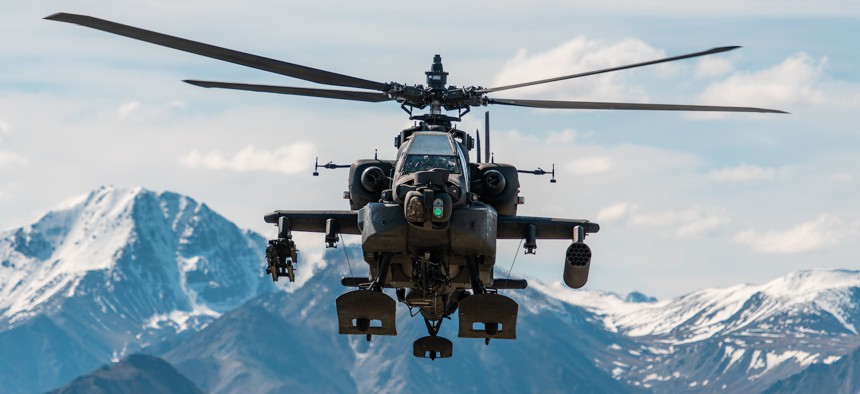
U.S. Army AH-64D Apache Longbow attack helicopter assigned to 1st Battalion, 25th Aviation Regiment Attack Reconnaissance Battalion (ARB) in flight over an Alaskan mountain range near Fort Wainwright, Alaska, June 3, 2019. U.S. Army / CW2 Cameron Roxberry
Defense Business Brief: A new space-sensor play; Speed bump for L3Harris-Aerojet deal; Boeing’s big Apache order; and more.
The private equity firm behind satellite-sensor maker Geost has created LightRidge Solutions, a company focused on “the development, design and production of small, affordable, high-performance space and airborne sensors and payloads for vital national security needs.”
LightRidge is made up of Geost and Ophir, which makes airborne laser radar sensors.
It is led by Bill Gattle, a former L3Harris Technologies executive with more than three decades of experience in the aerospace and defense sector. If Gattle’s name seems familiar, it’s because he’s been quoted here (and here, here, here, here, here, and here) when he ran Harris’ and then L3Harris’ space segments.
We told you about Geost, a company specializing in technology that can detect threats to satellites, in August 2021 when it was acquired by ATL Partners. Since then the firm has grown 600 percent, according to Josh Hartman, a former Pentagon official who is chief strategy and growth officer of LightRidge and president of Geost.
“The continued relationship with ATL allows us to further the trail of innovation, meaning it's changed our risk profile, we have greater capital resources that allow us to take larger risks, to move more rapidly into the emerging markets and to build out the scaling infrastructure that's required as we continue to grow,” Hartman said Monday.
The organic growth at Geost, which in the past 12 months has hired 100 people, and the acquisition of Ophir allows LightRidge to compete for more government business.
“It makes us much more competitive.for the missile warning and tracking marketplace where we have been before,” Hartman said. “It also allows us broader access in the airborne [intelligence, surveillance, and reconnaissance] market.”
Ophir’s LIDAR technology can detect contrails, the vapor trails produced by aircraft engine exhaust. Its sensors are installed on a number of military aircraft, including the B-2 stealth bomber, according to the company.
“They complement Geost in that they are an optical systems house that provides additional capability that we didn't already have,” Hartman said.
Ultimately, the company is looking to build what Hartman calls a “smart sensor.”
“How do we bring hardware and software together in more of a marriage to make the payloads much more powerful and smaller at the same time?” he said.
The company is growing its production and research-and-development capacity, Hartman said. And more growth, including two more acquisitions, are on the horizon.
“We expect that not only will we have continued organic growth that matches the rate at which we've been growing previously, but we'll continue to make acquisitions,” he said.
Welcome
You’ve reached the Defense Business Brief by Marcus Weisgerber. Send along your tips, and feedback to mweisgerber@defenseone.com or @MarcusReports. Check out the Defense Business Brief archive here, and tell your friends to subscribe!
In other M&A news, the Federal Trade Commission has requested additional information from L3Harris Technologies about its planned acquisition of Aerojet Rocketdyne. If this all sounds familiar, it’s because it happened in 2021 when Lockheed Martin planned to buy Aerojet. Lockheed scuttled the acquisition a year later, after the FTC sued to block the deal.
The FTC’s latest request came one day before Aerojet shareholders “overwhelmingly approved” the deal. “We continue to respond to Federal Trade Commission inquiries as we move toward an expeditious closing,” L3Harris CEO Chris Kubasik said in a statement. The company still expects the deal to close this year.
The second request reduces the odds that the acquisition will go through as proposed, according to a Georgetown Law paper that looked at merger enforcement statistics from 2000 to 2020. It found that only 28 percent of proposed M&A transactions receiving a second request were approved as is. About 40 percent were approved with consent decrees, while 30 percent were abandoned. The remainder went to trial.
An important caveat: These stats were the norm before the Biden administration in 2021 installed FTC Chair Lina Khan, who has taken a more aggressive approach toward antitrust enforcement.
In Congress, Sen. Elizabeth Warren, D-Mass., has urged the FTC to block what she called a “dangerous transaction.”
Bonus: Check out my Washington Technology colleague Ross Wilkers’ take on the FTC second request.
Elsewhere in the rocket sector, Virgin Orbit is looking for investors to avoid bankruptcy, which it might enter this week CNBC reports. The company halted operations last week and began furloughing employees, Sky News reports. This all comes on the heels of the failed January launch of a Virgin Orbit rocket from a Boeing 747. The U.S. Naval Research Lab lost two satellites during the failed launch.
All of this is happening as the United Launch Alliance, a joint venture between Lockheed Martin and Boeing, is reportedly for sale and the space industry is dealing with a launch shortage.
One more move on the M&A front: Aircraft maintenance firm AAR has acquired Trax USA, an independent provider of aircraft maintenance, repair and overhaul services and fleet management software.
Finally, Boeing won a massive $1.9 billion deal for 184 Apache helicopters for the U.S. Army and allied militaries.




